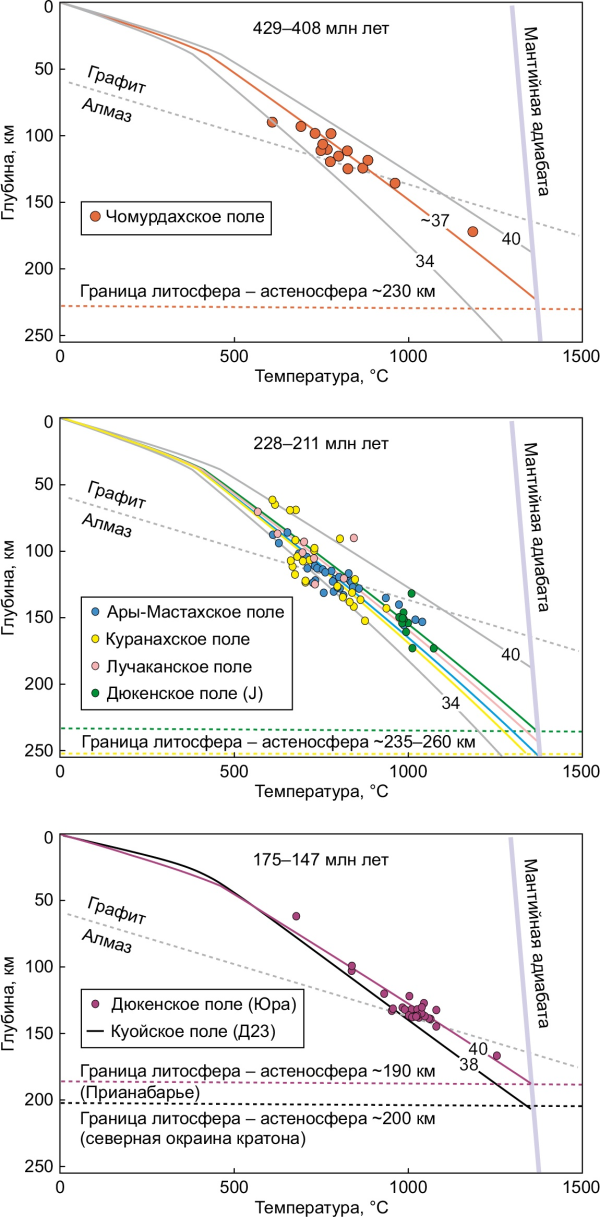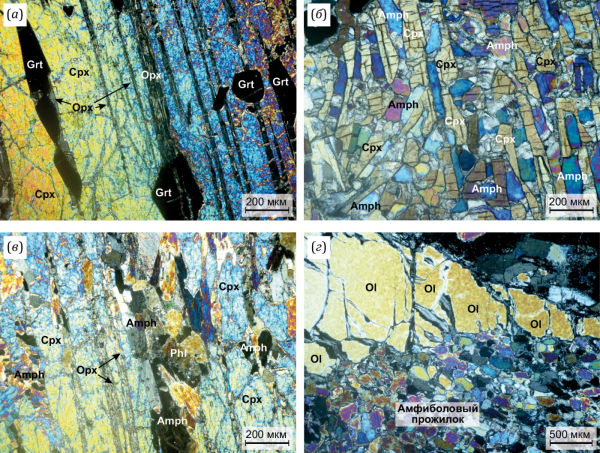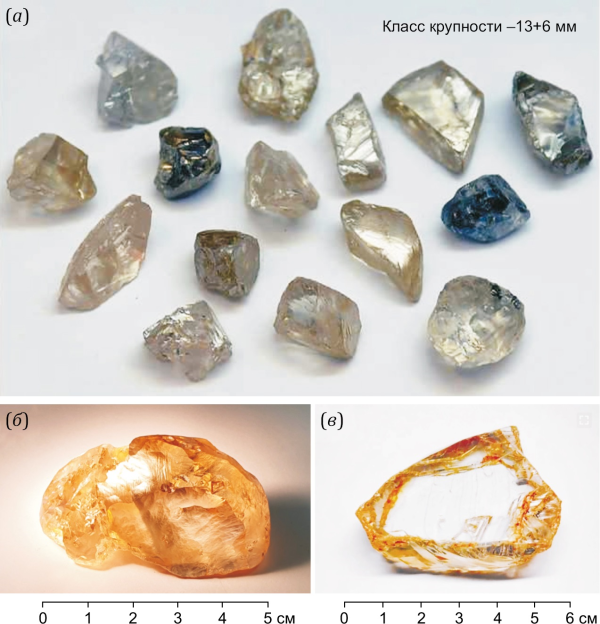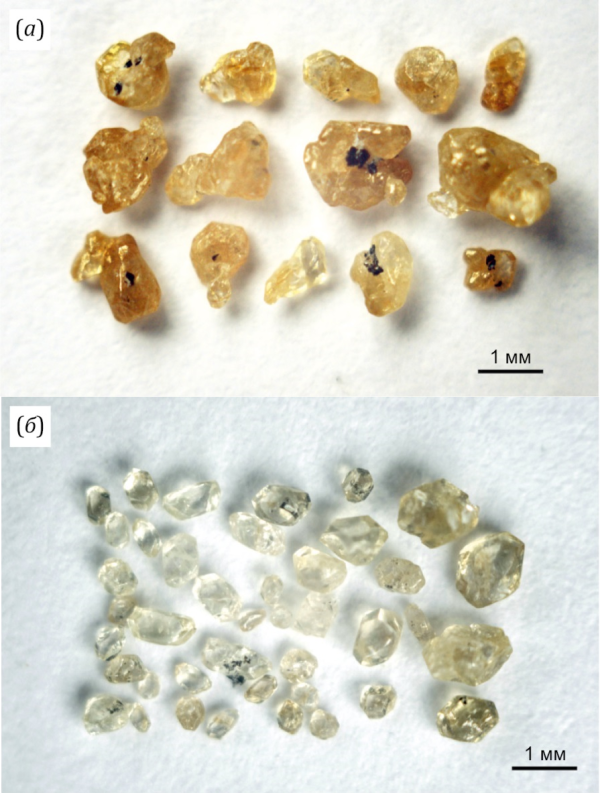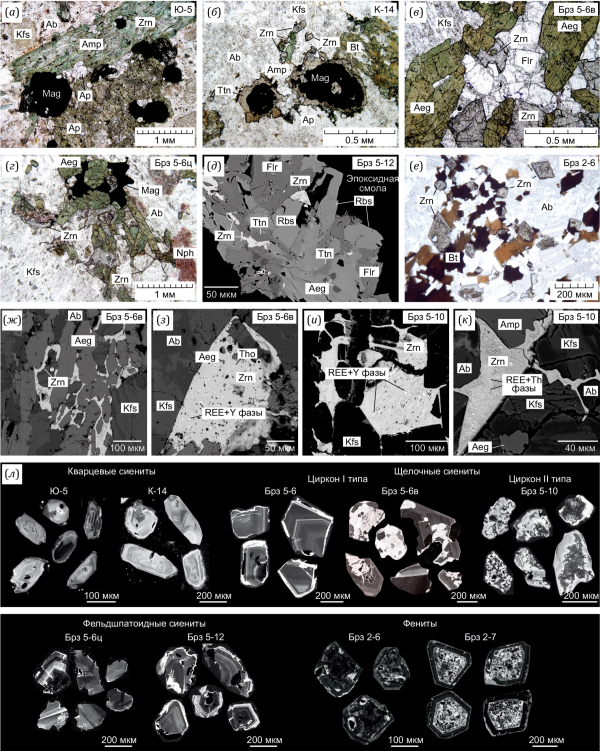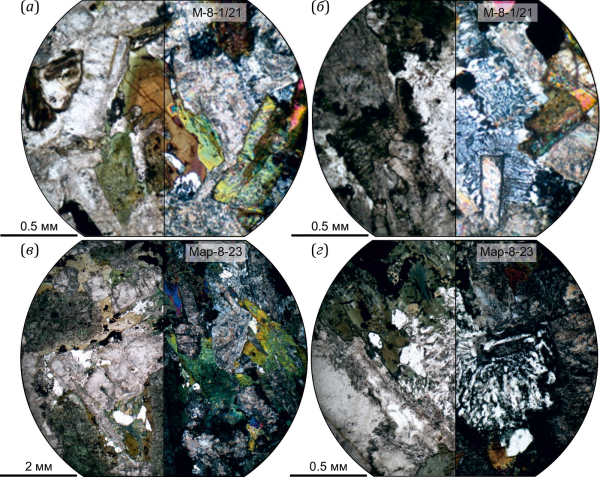EDITORIAL
PALEOGEODYNAMICS
The thermal history and thickness of the lithospheric mantlebeneath the kimberlite fields of the Eastern Anabar shield and adjacent territories of the Siberian craton were reconstructed based on the composition of clinopyroxene xenocrysts from the concentrate of kimberlite heavy fraction and mantle xenoliths. Garnet and spinel peridotites are most abundant in the lithospheric mantle beneath the five studied fields of the Siberian craton. Almost in all fields, the Mg# index of clinopyroxene decreases through depth. In the oldest Chomurdakh kimberlite field, both TiO2 and FeO contents vary slightly. The titanium oxide values markedly vary from 0 to 0.6 wt. % in the Triassic fields. The high titanium oxide contents in minerals are indicative of deepseated metasomatic transformations of lithospheric mantle blocks in the northern Yakutia kimberlite province. The geotherm was fitted to the PT data set in the Gtherm program with the model involved D. Hasterok and D. Champan. The thermal lithosphere beneath the studied fields retained the thermal thickness up to 260 km. In the period between 430 and 230 Ma, it underwent a significant metasomatic transformation resulting in the formation of highFe and highTi blocks. It appears, that the thermal thickness declined to 190–200 km only in the north of the Siberian craton during the Jurassic period. This assumption is verified by the values of lithosphere thickness beneath the northern Kuoika field.
This paper devoted to the mantle xenoliths with evidence of modal metasomatic alteration from the Obnazhennaya kimberlite pipe (Kuoika kimberlite field). The first data presents for trace elements content in minerals from such rocks, and they are compared with xenoliths from this pipe having no evidence of modal metasomatism. Based on the trace elements content in clinopyroxene and amphibole, as well as 40Ar/39Ar dating of phlogopite, it was concluded that enriched in Nb+Ta and REE melt-fluids were formed beneath the Kuoika field in the Lower Proterozoic, which lead to the phlogopite-amphibole formation from pyroxene.
An assessment was made of the possibility of using olivine thermobarometry for xenoliths of depleted peridotites from the Udachnaya pipe (Yakutia), represented by 76 megacrystalline dunites and 5 megacrystalline harzburgites. Specially developed and tested method of microprobe analysis was used to determine Al and Ca microimpurities in the olivine samples studied. PT-parameters of megacrystalline dunite xenoliths were calculated using the equations of olivine, garnet, and olivine-garnet thermobarometers. Enstatite geobarometers were additionally used for some megacrystalline harzburgites. Comparison of the obtained data showed that the geothermobarometric pair of FinnertyRigden barometer (Ca in olivine) for wide PT-range peridotites and thermometer [Bussweiler et al., 2017] (Al in olivine) for garnet peridotites is most suitable for assessing the PT-parameters of the megacrystalline dunite collection studied, though some of the high PT-parameters (>60 kbar and 1200 °C) are questionable. Garnet barometer [Grütter et al., 2006] (CaO – Cr2O3 ratio in pyrope) does not always agree with olivine geothermometers. This may be caused by the necessity to adjust the barometer equations for a wider range of compositions, as well as by the possible imbalance between garnet and olivine. We admit that more accurate results can be obtained by using this barometer in combination with garnet thermometers based on the determination of Ni in garnet. There is not enough data on harzburgites to draw certain conclusions. However, it should be recognized that the traditional pair of McGregor enstatite barometer and O’Neill-Wood garnet-olivine thermometer still remains the most acceptable for estimating the PT-parameters of megacrystalline harzburgites, though with some temperature underestimation.
The paper presents the results of studies of daughter olivine within secondary melt inclusions marking healed cracks in olivine macrocrysts from unserpentinized kimberlite from the Udachnaya-East pipe. Macrocrysts compose four olivine generations: core olivine (Ol1); olivine marking healed cracks (Ol2); daughter olivine of melt inclusions (Ol3); thin outer rims of olivine (Olr) around macrocryst cores. The relationship between different olivine generations and variations in its chemical composition indicate that macrocrystal cores (Ol1) are grains or grain fragments of disintegrated mantle rocks; melt inclusions and Ol2 were formed due to infiltration of kimberlite melts into the grain cracks. Crystallization of a hybrid melt of inclusions and formation of an extremely magnesian daughter olivine (Ol3) occurred later, at lower PT conditions. Among the daughter minerals in the melt inclusions, in addition to Ol3 there were identified alkaline carbonates, sulfates, chlorides, oxides, and sulfides. It has been shown that the daughter olivine of melt inclusions (Ol3) has high Mg# (97–98) content, high MnO (0.18–0.41 wt. %) and CaO (0.12–0.25 wt. %) concentrations, and low NiO (0.02–0.04 wt. %) contents. The ratios between the daughter minerals of the melt inclusions indicate that the hybrid melt from which extremely magnesian olivine was formed was alkaline carbonate or silicate-carbonate liquid with a low water content. Our study directly showed for the first time that almost pure forsterite is able to be crystallized from evolved kimberlite melts of carbonate or silicate-carbonate composition, which confirms the previously proposed model for the formation of extremely magnesian outer rims of olivine crystals from worldwide kimberlites during crystallization of evolved kimberlite melts of carbonate composition.
The finds of giant CLIPPIR-type diamonds in the placers hosted by the Ebelyakh River basin in the north of Yakutia suggest that similar diamonds can be found in the kimberlites of the Anabar region and the nearest northern deposits located within the collisional Khapchan and Daldyn terranes. To predict the discovery of such diamonds, the authors use the 5E diagram method based on the principle of similarity of the compositions of five oxides of satellite minerals (Grt, Cpx, Chr and Ilm) of diamond (DSM) with the reference diagrams for the Karowe pipe (K-6, Botswana) with the composition of those for any other pipe. It was previously shown that the convergence of the DSM compositions of the Karowe and V. Grib (Arkhangelsk diamond province) pipes is 74 %, which might indicate possible presence of CLIPPIR diamonds in the predicted pipe. The application of this technique to two kimberlite pipes of the Anabar region demonstrated that the probability of detecting such diamonds in the Leningrad pipe (Lower Devonian, medium diamond content potential) is 74 %, and in the Malokuonamskaya pipe (Lower Triassic, medium diamond content) is 20 %. A comparison of diagrams 5E and additional PTС – fO2 diagrams of reconstructed sections of the lithospheric mantle showed their efficiency in predicting favorable conditions of CLIPPIR-type diamond crystallization. It is assumed that formation of such diamonds may occur within the proto-kimberlite magmatic chamber located near the boundary of the lithosphere and associated with the asthenospheric source. It should be surrounded by low-oxidized carbon-rich mantle eclogites and dunites with high pressure and temperature, as well as magnesium-rich ilmenite-chromite metasomatites. The use of the 5E diagram method, as the approach to predict giant CLIPPIR diamonds in poorly diamondiferous kimberlites, might attract investing for exploration to audit the industrial potential of a series of such kimberlites in the Anabar region. Its implementation would significantly increase the efficiency of geological exploration and assessment of the potential of poorly diamondiferous pipes that have been suspended as subeconomic.
Neoproterozoic Samalpatti and Cretaceous-Paleogene Amba Dongar massifs are considered to evaluate the change of sources of carbonatite magmatism in evolving tectonosphere of India. The inherited character of Ba and Sr distribution components is traced in heterogeneous carbonatites of India, whereas the independent trends in Ba and Sr enrichment are traced in carbonatites of North Asia. It is inferred that in the process of activity in the tectonosphere of the Indian subcontinent ~800 Ma ago, carbonatite melts were generated in the mantle whose photolith has an age of 4.26 Ga. This protomantle reservoir was remarkably different from the primordial mantle reservoir in the solidified magma ocean in terms of low initial μ and high initial Nd isotope ratio. After the Indian subcontinent had separated from Gondwana 130–100 Ma ago and began to join Asia ~66 Ma ago, ELMU source was activiated in the tectonosphere. The Amba Dongar carbonatites might have been derived from the 4.40 Ga mantle protoliths. Silicate melts of the Deccan LIP were simultaneously generated from the protoliths with Pb-Pb age of ~2 Ga.
The Ilmen-Vishnevogorsky and Buldym carbonatite complexes occurring in the Southern Urals represent linear deformed carbonatite complexes. Their origin, as well as the age and geodynamic conditions remain the subject of debate. The isochron methods (Rb-Sr, Sm-Nd, TIMS) and local U-Pb-dating of zircons (SHRIMP II and LA-ICP MS) of these carbonatite complexes were employed to determine the age and duration of the stages of alkali-carbonatite magmatism and associated rare-metal ore formation. The Silurian-Devonian U-Pb zircon ages of the early phases of Ilmen-Vishnevogorsky miaskites and carbonatites were determined as 420.7±11 Ma (S2) and 417±2.8 Ma (D1), respectively. In the later phases of miaskites and carbonatites, early zircons are resorbed, they have broken isotope systems, and later zircon generations form a cluster of 386±7.6 Ma (D2). The Lower Permian U-Pb age of zircon 280±8 Ma (P1) was determined in the miaskite-pegmatite and late carbonatite. The isochron dating of late ore-bearing varieties of carbonatites provided the ages from the Lower Permian to the Early Triassic (P1–T1): 254±18 Ma, Sm-Nd and 247±4 Ma, Rb-Sr, IVC; 280±53 Ma, Sm-Nd, Buldym complex. Thus, the generation and intrusion of alkaline magmas in the Urals occurred ~420 Ma (S2–D1), synchronously with the formation of island-arc complexes. They are related to rifting on the emerging continental margins. The tectonic activity and formation of alkaline rocks and carbonatites proceeded in the Middle Devonian (~380 Ma, D2); it correlates with the accretion-collision stage of the Urals development. At the stage of "hard" collision (~280 Ma, P1), the Ilmen-Vishnevogorsky and Buldym complexes were plastically deformed, underwent melting and emplaced conformably with collision-slip tectonic structures. Recrystallization of rocks and minerals, plastic and brittle deformations, processes of pegmatitic, carbonatitic and rare-metal ore formation are associated with palingenic-metasomatic transformation of rifting alkaline complexes of Silurian-Devonian age at the collision and post-collision (~250 Ma, P3–T1) stages of the Urals emplacement.
The paper reports the comprehensive study of phosphorus-rare metal (polymineral) carbonatites (I) and rare metal (ankerite) carbonatites (II) of the Tomtor massif based on ICP-MS, XRF, XRF-SI, SEM methods and isotope determination of C, O and 86Sr/87Sr. With a similar mineral composition, the REE+Y content in carbonatites (I) averages 0.38 wt. %, and in carbonatites (II) it is 1.3 wt. %. The δ18О-δ13С diagram provides the C and O isotopic compositions of carbonatites (I) and (II) as two intersecting trends: (I) carbonates from wells 4041, 6151, 115-117 represent the secondary generation of carbonates derived with the deuterium fluid involved; (II) depicts transformation of carbonate by low-T fluid, with fluid/rock ratio = 5. The study identified an increase in the REE and δ18O contents in carbonatites as the temperature of their formation decreases and enrichment of rocks with REE minerals, associated with REE mobility reduction in the fluid while the temperature is decreasing.
Four types of mica were identified in the macrocryst and fine porphyry aillikites from the Yarma zone of the Urik-Ija graben considering specific features of morphology, chemical composition, zonation and crystallization conditions. Mica of the first type was found in macrocryst aillikites. It is available as deformed phlogopite macrocrysts rich in TiO2 (2.5–5.7 wt. %) with varying content of Cr2O3 (from detection limit to 2.0 wt. %) and Mg# 0.87–0.89 and 0.79–0.81 in different dikes. In chemical composition this phlogopite corresponds to the secondary phlogopite from mantle xenoliths, and it was obviously captured by protoaillikite melt form the rocks of the lithosphere mantle. Mica of type 2 represents phlogopite from groundmass and infrequent phenocrysts in fine porphyry aillikites and groundmass of macrocryst aillikites. In this phlogopite, TiO2 content varies in different dikes from 0.7 to 6.0 wt. %, Mg# index varies from 0.70 to 0.90. Phlogopite crystallized within the upper crust at temperature ranging from 840 to 680 °С. Mica of type 3 represents biotite (Mg# 0.40–0.65), producing rims around phlogopite and independent grains in fine porphyry and in places in macrocryst aillikites. The rims crystallized from residual Fe-rich melt at moderately heightened fO2, the temperature of biotite formation reached 700‒760 °C. Mica of type 4 is available in macrocryst aillikites as biotite (Mg# 0.40‒0.67) with phlogopite rims. It was inferred, that this biotite crystallized in intermediate magmatic chambers in the upper crust from essentially carbonate melts, separated through crystallization differentiation from protoaillikite magmas and captured by new portions of less differentiated melts. Obtained data point to metasomatic transformation of the lithosphere mantle, preceding to protoaillikite melting, under the southern margin of the Siberian craton. Thus, we may assume existence in the upper crust of the sites composed of partially crystallized melt.
This paper reports investigation on zircons from quartz syenite, alkaline and foid syenite, as well as metasomatic rock from the fenitization zone hosted by the Burpala massif. It is performed by scanning electron microscopy with energy dispersive X-ray spectroscopy (SEM/EDS), cathodoluminescence (CL), laser ablation inductively coupled plasma mass spectrometry (LA ICP MS), and Raman spectroscopy. Generally, all zircons from igneous rocks show rhythmic, crystal growth zoning or sector zoning (type I) except for some zircons from alkaline syenites (type II) showing patchy zoning. They systematically contain pores or cavities. The REE patterns of magmatic zircons share similar features: e.g. depletion of LREE ((Yb/La)N up to 35000), large positive Ce (Ce/Ce* 6–427) and small negative Eu (Eu/Eu* 0.37–0.93) anomalies. Zircons crystallized from quartz syenites at 830±30 °C at the early stage of rock formation, while zircons from alkaline and foid syenites crystallized at the later stage of rock formation (680–750 °C). Meanwhile, crystallization of zircons with rhythmic zoning (type I) occurs at later magmatic stage, while the formation zircons of type II is probably related to the separation of the highly fluorinated aqueous fluid from the residual melt.
Zircons from fenites have a bipyramidal habit holding a heterogeneous mosaic core and a homogeneous (or rhythmic zoning) rim. The cores of zircon show flat REE patterns without significant anomalies, while the rims are characterized by noticeable fractionation of REE ((Yb/La)N 85–615) and show a positive Ce anomaly (Ce/Ce* 4–18). The Raman spectra of the cores show a higher degree of crystallinity than the rims, and their flat REE spectra are probably related to the contamination by micro inclusions. The discordant U-Pb age of 295±3 Ma was obtained for zircon rims, which is consistent with the age of formation of igneous rocks of the Burpala massif (298–291 Ma). The latter supports the syngenetic origin of metasomatic ore mineralization with the main stage of massif formation.
This paper presents a comparative analysis of geochronological, geochemical, Sr-Nd isotopic data and geodynamic conditions for the Devonian magmatism of the East European Platform, using as an example the Pripyat-Dnieper-Donets rift zone in the south of the platform and the Kola alkaline province in the north.
The Late Paleozoic rifting in the south of the platform was accompanied by magmatism, which formed a wide range of rocks, from alkaline-ultramafic lamprophyres and orangeites, non-diamondiferous kimberlites and carbonatites to typical tholeiites, trachyandesites, and trachyrhyodacites. Activation of rifting processes in the north of the platform has also produced a compositional diversity of magmatic occurrences dominated by kimberlites, in particular diamondiferous (Arkhangelsk diamond-bearing province), which is the main distinctive feature of the place. The Pripyat-Dnieper-Donets rift zone is subject to reverse lateral geochemical zonality of the mantle sources – from those depleted in the axial zone of the Dnieper-Donets trough to more enriched in the marginal parts – trough shoulders (Azov region, Voronezh crystalline massif): along the southeast to northwest axis of the rift zone to the Zhlobin saddle (orangeites, alkaline picrites of the Zhlobin alkaline-ultramafic complex) and in the Pripyat trough (Pripyat alkaline and subalkaline mafic complex) as well was perpendicular to the axis from the central part of the Dnieper-Donets trough to the southwest towards the Eastern Azov region (non-diamondiferous kimberlites) and to the northeast towards the Voronezh crystalline massif.
Currently available petrological-mineralogical and isotopic-geochemical data on magmatites of both large magmatic structures suggest significant lithospheric heterogeneity, different types of sources of formation of rocks, and a significant influence exerted by the crustal component both in the southern and northern parts of the East European platform.
This work focuses on petrological-and-geochemical features, as well as age of dolerites widespread within the basins of the Mara, Kamenka and Uvat rivers. The isotope geochronological data acquired for baddeleyite allowed referring origination of these rocks to the time interval 1600–1620 Ma, interpreted as the time of their emplacement. It was ascertained, that the age of dolerites represents particular geological event proceeding independently of formation of Neoproterozoic Nersinsk gabbro-dolerite complex. The Sm-Nd isotope signature indicates that parent melt generated from the metasomatic lithosphere mantle.



